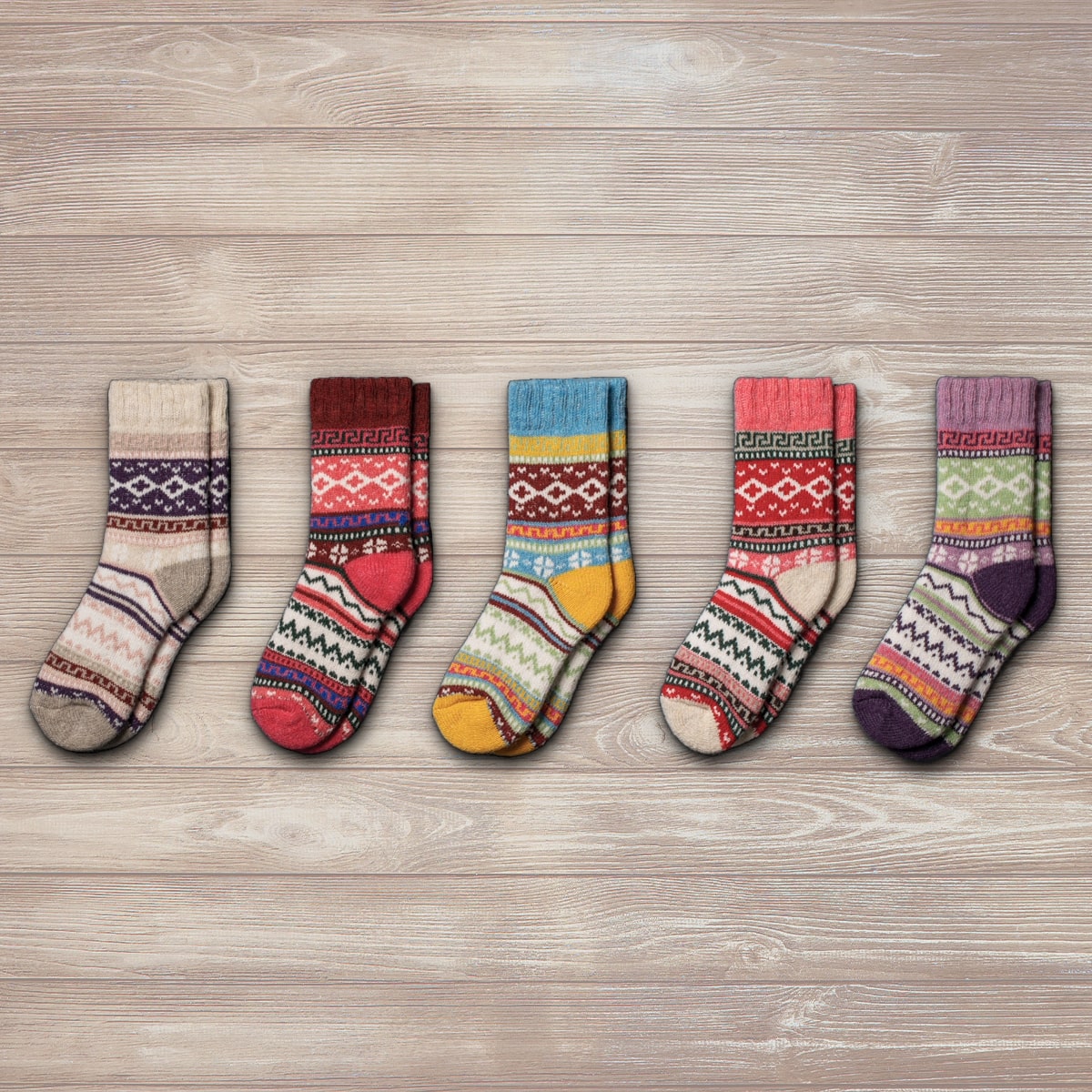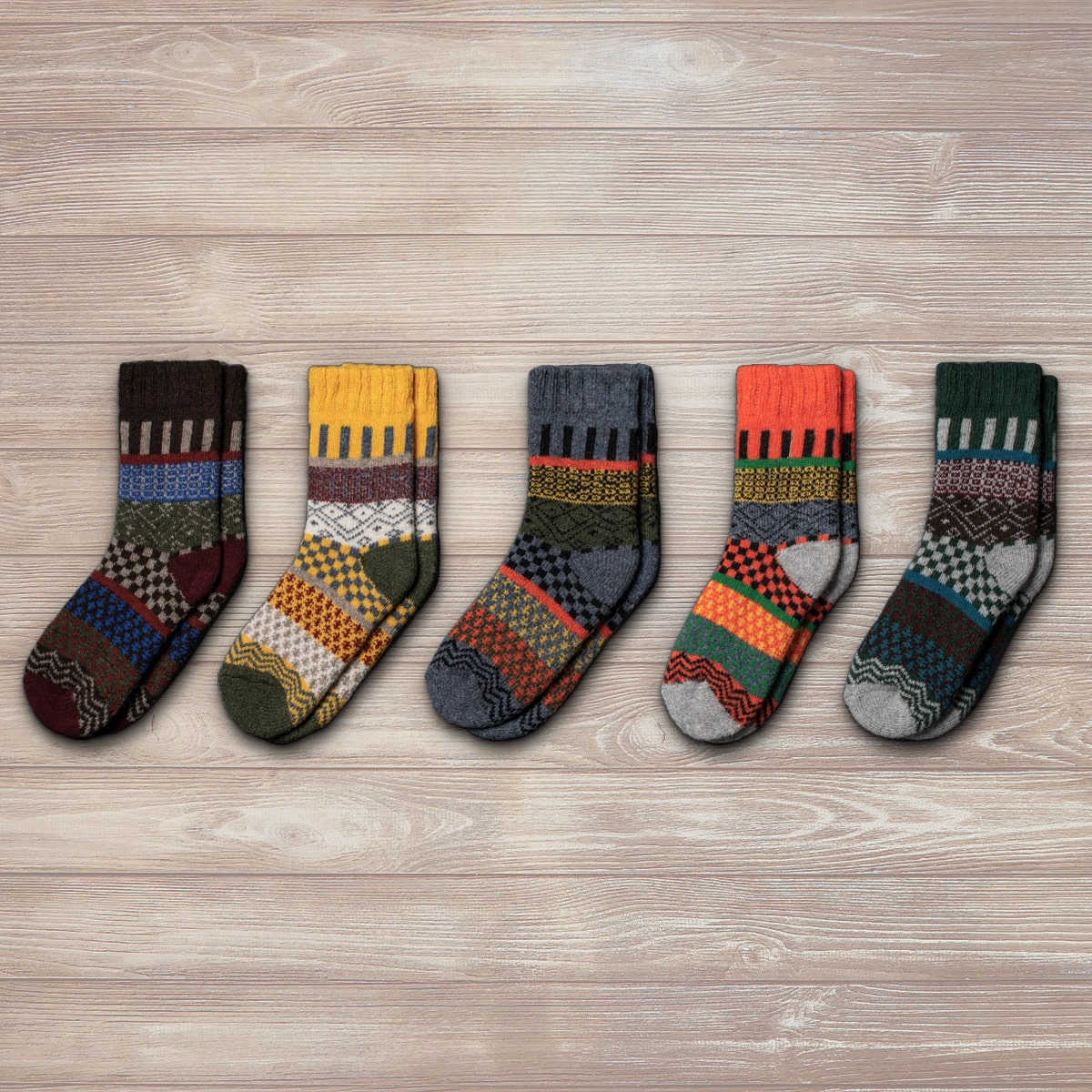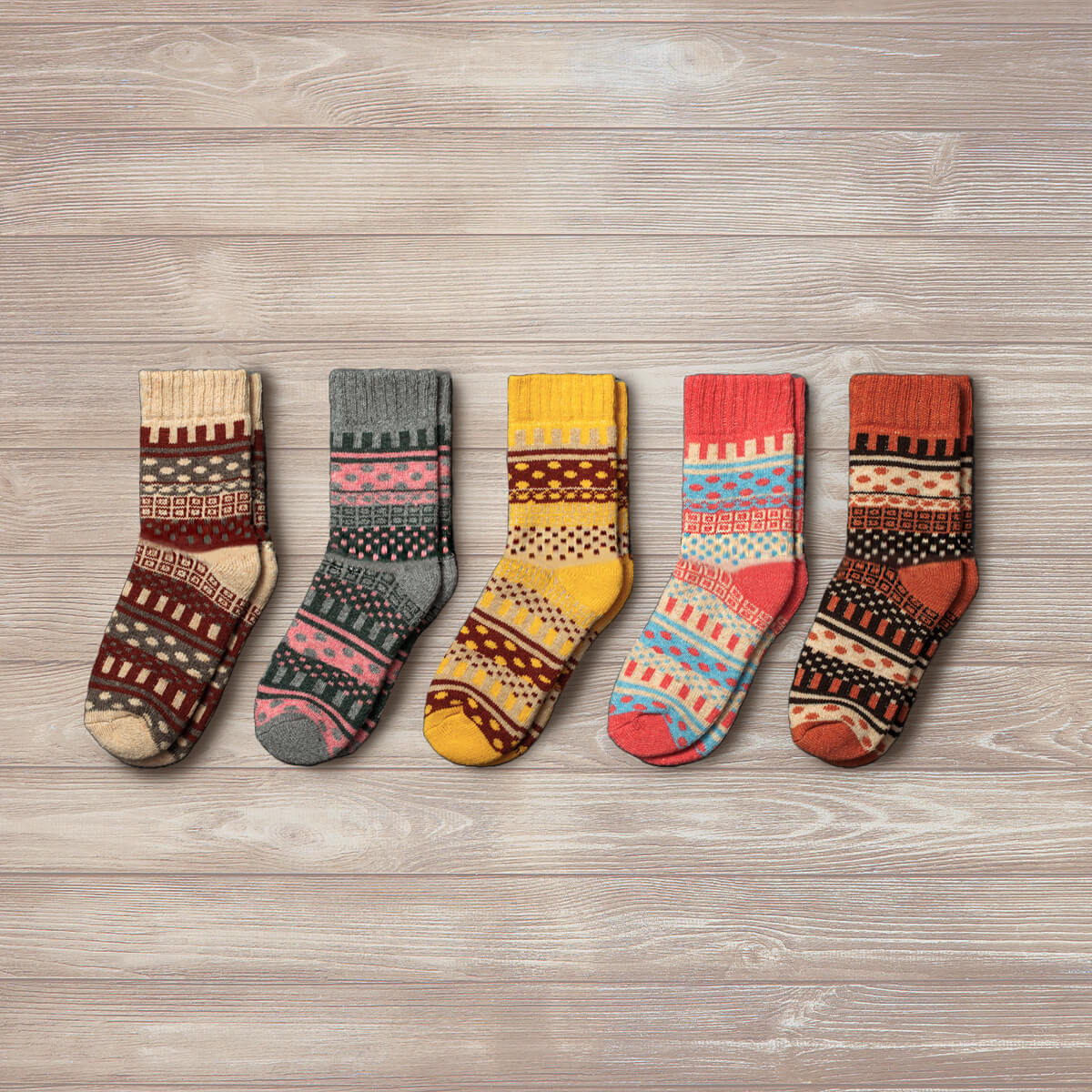Your Cart is Empty

The Cultural Inspiration Behind Our Sock Designs
7 min read
This article explores the deep-rooted cultural significance of Nordic knitting traditions and how they have evolved into both art and everyday wear. Highlighting techniques like Continental and Norwegian knitting, it explains how these methods reflect the region's climate and identity. The narrative underscores how knitwear in the Nordic Peninsula—especially in Norway, Iceland, Sweden, and Finland—has transitioned from functional warmth to cultural storytelling, featuring symbols such as the Selburose, Marius pattern, Setesdal, and the revered Yggdrasil (Tree of Life). These motifs are not just decorative but emblematic of Norse mythology, community, and a life in harmony with nature. With a spotlight on Nordic Socks, the piece emphasizes the brand’s dedication to preserving cultural legacies through premium Merino wool socks that are ethically sourced, lanolin-free, mulesing-free, and RWS certified. Blending sustainability with timeless design, Nordic Socks celebrates the region's millennia-old traditions with modern-day comfort.
The most famous designs in the world carry a profound cultural legacy. Nordic socks are the perfect example of heritage turned into a statement.

Celebrating Roots Through Design
Knitting traditions across Europe are as diverse and storied as the cultures that nurture them. On the Northern Peninsula, where craft is often interwoven with heritage and climate, knitting serves not just as a necessity but as a cultural signature. Among the most distinguished European knitting techniques are the Continental (also known as German) and Norwegian styles—each rooted deeply in regional identity and utility.
Continental knitwear focuses on a “complete” purl stitch, where you bring the wool yarn back in front after completing the stitch. The Norwegian knitting technique does not bring the yarn back; instead, it creates a stitch through light hand motions.
Both styles are highly efficient since they let the knitter maintain adequate tension on the needle. If excess pressure is applied, the resulting knit becomes bulky. Lack of pressure, on the other hand, creates a loose and also heterogeneous knit.
But besides sheer technique, what differentiates Continental (or German) knitting and its Northern counterpart? Heritage.
Why Cultural Heritage Matters in Everyday Wear
Everyday wear is with you… every day – as such, it plays a significant role in your mood and how you relate to others. Psychological studies show that experimenting with colors and patterns helps tremendously with confidence. It also helps you be mindful of yourself and the people around you. The term for this phenomenon—enclothed cognition—was coined by psychologists Hajo Adam and Adam Galinsky. The term refers to feeling more grounded in the present moment when you put thought into your outfit and your outer appearance in general.
Cultural heritage is the mark of authenticity. It also emphasizes that knitting is a craft, and working by hand is more sustainable and eye catching than opting for fast fashion.
Nordic culture also puts great emphasis on knowing oneself and one’s background. From preserving Icelandic as it was 1000 years ago to celebrating unity in diversity, Northerners are fond of highlighting culture in all shapes and forms. These forms include, of course, knitwear!
A Brief History of Nordic Knitting Traditions

From Function to Folklore: The Evolution of Nordic Knitwear
Nordic culture goes a long way back, and knitting is one of this culture’s pillars.
The Nordics became interested in knitting when they first imported tapestries in the late 1400s and early 1500s. The world’s first masters of the craft hailed from Syria and Egypt, and they soon reached the court of Queen Elizabeth I of England. From then, fine knitwear also reached the Scandinavian Peninsula.
The European continent developed its technique, with distinguishable styles in Western lands like present-day Germany and the UK. For the Nordics, emulation of Continental knitting styles soon became a separate school of this craft.
Norway is the epicentre of knitwear, with the earliest sources attesting to this practice in the 16th century. The art of knitting started as a functional need. After all, we are talking about one of the coldest areas on Earth. The aesthetic element also started gaining momentum. A key moment occurred at the end of the 19th century due to extensive tourism and migration.
As Continental tourists started venturing more and more into the Peninsula, they spotted the famous Norwegian mittens, adorned with unique patterns.
Similar practices with their unique spin also emerged in the rest of the Scandinavian Peninsula. Iceland, Finland, and Sweden are as adept in the intricacies of knitting.
Storytelling in Stitches: The Role of Symbolism in Patterns
Nordic patterns are adept at telling a story of long-standing culture. Elements like the tree of life (Yggdrasil) reference the Poetic and Prose Edda. These writings detail Norse mythology, which has recently gone beyond the borders and become a pop culture staple.
The act of wearing Nordic patterns means wearing the remnants of a highly influential civilization that has morphed today into an example of contentment and connection to nature.
Regional Influences: Norway, Iceland, Sweden, and Finland
Norway is the most famous Scandinavian country when it comes to knitting. Although most designs hail from there, it would be unfair to overlook Iceland, Sweden, and Finland. Each Nordic country has its own spin on `kofte`, or knitwear.
In Finland, this craft is also a hobby for many Finns of all ages. Besides the act of creating garments, it has always had a strong social component. The knitting style resembles the Norwegian one, but there is an emphasis on spirals and circular patterns. The sharp edges from Selbu or Setesdal are more subdued in this neighboring country.
Iceland, on the other hand, is the origin of the universally recognised Lopapeysa, a wool sweater characterized by its circular yoke adorned with distinctive patterns.
Sweden knitwear closely resembles Norwegian style. However, there is an emphasis on flowers and vegetal nature in general.
Iconic Nordic Knitting Patterns
![]()
Selburose (Selbu Star)
The Selburose is a sharp, octangular rose. It is also the most famous Norwegian knitting pattern. Its name evokes the municipality of Selbu. The stylized rose design is also similar to a star, and the design is equally as well-known as ‘Selbu Star’. It started out as a pattern most commonly found on mittens.
It sprang to public attention in the late 19th and early 20th century, soon gaining Scandinavian, European, and eventually worldwide recognition.
Marius Pattern
The Marius pattern is a staple of Nordic knitwear. The pattern is generally associated with men’s clothing, but it has recently become more of a unisex print. Its origin is modern and widely disputed. The name ‘Marius’ comes from a fighter in WWII, by the name of Marius Eriksen. The soldier also had a lucrative career as an actor, model, and professional skier. With his all-Norwegian looks and performance on the ski slopes, he became an icon of Norwegian winter sports and its associated knitwear. His appearance on the movie poster of Trol I Ord (Troll in Words) clad in a traditional sweater, made him truly become the ambassador of this pattern, willingly or not.
Setesdal (Lice Pattern)
Setesdal is another toponym, a valley in Norway’s Agder County. The traditional lusekofte is also named Setesdalsgenser, meaning `sweater from Setesdal`.
The intricate design features stylized crosses, which are traditionally black and white. However, there are multiple variations. Nowadays, combining Setesdal and Selburose prints is a fashion and cultural statement.
Lusekofte Dots
The Lusekofte Dots resemble symmetric, angular specks. Like the Setesdal print, Lusekofte is associated with sweaters, but it is also a favourite for socks and mittens. In many places, Setesdal and Lusekofte are used interchangeably, although Lusekofte refers more specifically to the unique speck design.
Lopapeysa Yoke (Icelandic Sweater Design)
Do you know the classic ‘Christmas sweater pattern`? It is in fact the Icelandic Lopapeysa Yoke. `Lopapeysa` translates literally to `wool sweater`, with `yoke` referring to the sharp patterns you see on the cuffs and collars of such sweaters.
Reindeer and Moose Symbols
Moose and reindeer represent a move away from the highly stylized Nordic kofte. Their detailed silhouettes often depict them clashing horns or looking up. These horned animals are the national symbol of Norway. They signify the communion between humans and wilderness.
Tree of Life & Geometric Fir Trees
Nordic heritage is intimately tied with Viking tradition, which is why the tree of life is an essential kofte pattern. The tree, Yggdrasil, is an intricate tree with barren and interlocked branches. It is said that the Nine Worlds of Norse mythology and cosmology gravitate around this tree, which is the origin of all life. Norse Gods would commune and convene by the Yggdrasil, which was at the center of the entire cosmos.
The Cultural Threads “Woven” into Nordic Socks

Honoring Nordic Culture with Modern Comfort
We invite you to bring the legacy of the North into your daily life. Our Nordic socks aren’t just accessories — they are expressions of cultural heritage. Inspired by the iconic patterns of Nordic knitwear, each pair celebrates the art, resilience, and traditions of the region.
Premium Materials: Merino Wool & Cotton Blends, European Craftsmanship, and Sustainability
At Nordic Socks, premium quality is not a marketing buzzword, it's a legacy. Our socks are crafted using premium Merino wool. Naturally, this thermoregulating material has always been a favorite of Northerners. It is beneficial not only because it keeps you warm even during the Polar Night, but also because it wicks away moisture.
Our Merino wool is:
- Sustainably harvested in Europe, a region known for some of the world's strictest environmental and animal welfare regulations.
- Mulesing-free, as we firmly oppose this inhumane practice. Ethical sourcing ensures the sheep are never harmed, aligning with the broader European commitment to animal welfare and humane production.
- Lanolin-free and perfect for skin that needs extra care.
- RWS Certified (Responsible Wool Standard) means our wool meets rigorous animal welfare and land stewardship criteria. This global certification guarantees that the animals and the environment are treated respectfully throughout production.
Northern Europe teaches us that there is no such thing as excessively cold or rainy weather. Comfort and joy are achievable at all humidity levels and temperatures! The same goes for being fashion-forward and celebrating a millennia-old heritage.
Frequently Asked Questions

Why is knitting so popular in Scandinavia?
Knitting holds deep cultural and practical significance in Scandinavia, rooted in centuries-old traditions and the region's cold climate. Historically, it was a vital skill passed down through generations, used to create essential garments like socks, mittens, and sweaters that could withstand harsh Nordic winters. Beyond function, knitting evolved into a form of artistic expression, with each country—Norway, Sweden, Denmark, Finland, and Iceland—developing distinct patterns and techniques that often carry symbolic meanings. Community and mindfulness also play a role; knitting circles foster social bonds, while the rhythmic process aligns with the Scandinavian appreciation for calm, intentional living. Today, knitting remains popular not only as a cultural heritage but also as a sustainable, hands-on craft that resonates with modern values of slow fashion and personal creativity.
Which country knits the most?
Iceland is often considered the country with the highest knitting participation per capita, with a strong cultural tradition where knitting is both a widespread hobby and a national symbol of identity.
Get Exclusive offers
Join our email list and get exclusive offers and 10% off on first order.
Recent Articles
-
 Are wool socks good for summer? July 29, 2025
Are wool socks good for summer? July 29, 2025 -
 The Cultural Inspiration Behind Our Sock Designs May 27, 2025
The Cultural Inspiration Behind Our Sock Designs May 27, 2025 -
 How to Care for Cotton Socks May 27, 2025
How to Care for Cotton Socks May 27, 2025 -
 Wool vs Cotton Socks for Hiking: Which is the Best Material for Hiking Socks? April 11, 2025
Wool vs Cotton Socks for Hiking: Which is the Best Material for Hiking Socks? April 11, 2025 -
 Foot Health: How Nordic Wool Socks Support Your Wellbeing February 18, 2025
Foot Health: How Nordic Wool Socks Support Your Wellbeing February 18, 2025
Enjoying this content?
Sign up to get notification about new articles, special offers and new products.
news & Updates
Get the newsletter to receive direct information about offers and new products.
Where are we shipping to?
Purchase from your country’s website.
It’s the fastest way to pamper your feet with comfy socks.





























































































